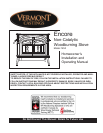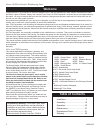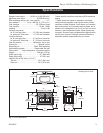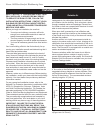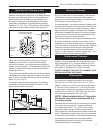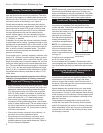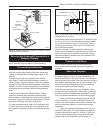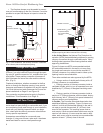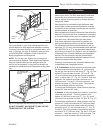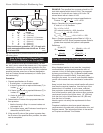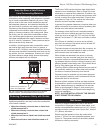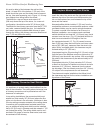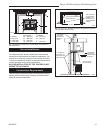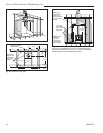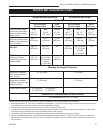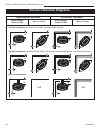
9
Encore 1450 Non-Catalytic Woodburning Stove
30002425
D
E
F
I
A
N
T
ST493
Brick pass thru
11/00
Wall Stud
Chimney
Connector
12” Noncombustible
Material
Floor Pro-
tection
ST493
Fig. 10 An approved wall pass-through for the United States.
Your local dealer or your local building inspector can
provide details for other approved methods of passing
a chimney connector through a combustible wall in your
area. In Canada, this type of installation must conform
to CAN/CSA-B365, Installation Code for Solid Fuel
Burning Appliances and Equipment.
NOTE: Do not vent your Encore into a factory-built
(zero-clearance) fireplace. These appliances together
with their specific chimneys are designed as a sys-
tem for use as fireplaces. It may void the listing or be
hazardous to adapt factory-built fireplaces for any other
use.
T
ST494
steel
wall pass thru
11/00
18” (460mm) clear
space all around
the pipe
ST494
Fig. 11 An approved wall pass-through for Canada.
DO NOT CONNECT AN ENCORE TO ANY AIR DIS-
TRIBUTION DUCT OR SYSTEM.
Floor Protection
A tremendous amount of heat radiates from the bottom
plate of your stove. The floor area directly under and
around the stove will require protection from radiant
heat as well as from stray sparks or embers that may
escape the firebox.
Heat protection is provided through the bottom heat
shield. Spark, ember and thermal protection must be
provided by a floor protector constructed with noncom-
bustible material as specified.
Most installations will require the bottom heat shield be
attached. Only when the stove is placed on a complete-
ly noncombustible surface such as unpainted concrete
over earth may it be used without the heat shield.
Even when the bottom heat shield is installed, you
must provide special protection to the floor beneath.
For installation with the heat shield attached, use an
approved 1/2” (13 mm) noncombustible hearth pad with
k = 0.84 BTU/in ft
2
hr °F or an equivalent material with
an R-value of at least 0.59. (Refer to “How to Determine
if Alternate Floor Protection Materials are Acceptable”
section) The floor protector may be covered with a
decorative noncombustible material if desired. Do not
obstruct the space under the heater.
Protection requirements vary somewhat between the
Untied States and Canada as follows:
U. S. installations the floor protector is required under
the stove and must extend at least 16” (not including
the ash lip) from the front of the stove (“F”, Fig. 12), and
at least 6” from the sides and rear. (“D” and “E”, Fig.
12) It must also extend under the chimney connector
and 2” to either side. (“C”, Fig. 12) For the 8” (203 mm)
connector, the protector must be a minimum of 12”
(305 mm) wide. For the 6” (152 mm) connector, the
protector must be 10” (254 mm) wide. The protector
must be centered under the connector.
To meet these requirements, a floor protector must be
at least 39” wide and 45” deep.
In Canada: A noncombustible floor protector is required
under the stove as well. The floor protector must
extend 18” (450 mm) to the front (“F”, Fig. 12), and 8”
(200 mm) from the sides and rear. (“D” and “E”, Fig. 12)
To meet these requirements, a floor protector must be
at least 43” (1092 mm) wide and 49” (1245 mm) deep.
Floor protection also must extend under the chimney
connector and 2” (51 mm) to either side. (“C”, Fig. 12)
For the 8” (203 mm) connector, the protector must be
a minimum of 12” (305 mm) wide. For the 6” (152 mm)
connector, it must be at least 10” (254 mm) wide. The
protector must be centered under the connector.



